Some animals have incredible regenerative abilities, growing new legs and tails to replace lost ones. Fish and salamanders can even grow new brain cells to repair damaged portions of their brains. As mammals, though, our capacity for regeneration is more limited, particularly where the brain is concerned.
“Lower vertebrates keep on replacing neurons quite happily throughout their life, but mammals don’t,” explains James Fawcett, a neuroscientist at the University of Cambridge. “We stop making new neurons before birth, pretty much, except for one or two small parts of the nervous system.”
This means that whilst we can repair a cut to our skin by growing new skin cells, we can’t recover from a brain injury in the same way. Instead, our brain’s only option is to work with the existing neurons – cells that carry all the information required for us to think, move and perform our normal bodily functions.
If the odd brain cell goes offline here or there, it’s not usually a problem, but the impact of a major brain injury depends on the type and site of injury, and how many neurons have been lost.
To some extent, what’s left can be remodelled – the brain has what we call ‘neuroplasticity’. Think of your brain as if it were Google Maps or another route planner. If one of the roads on the quickest route is being dug up, Google Maps will find you another route, even if it takes a bit longer.
Similarly, because each brain cell has thousands of different connections, your brain is capable of some fairly extensive re-routing of its signalling, says Mark Ashley, CEO of the US-based Centre for Neuro Skills, which helps patients to recover from brain and spinal cord injuries. “We may lose a highway or two, or several highways, but theoretically, we could find other highways.”
This means when the brain is injured it can try to bypass the damaged cells by forming new connections between neurons in order to drive the lost functions. Neuroplastic processes also occur when we’re learning new skills, but with a major brain injury it can result in some dramatic remodelling, even to the extent of entire functions being transferred to different parts of the brain – hearing, for example, can be taken over by the visual cortex, and vice versa.

Neuroplasticity relies on the nerve cells themselves, as well as support cells called glial cells that help make new connections and repair myelin, which is the protective covering around a nerve fibre that speeds up nerve impulses.
The nerve fibres (axons) that carry the signals do also have some capacity for sprouting new branches, when the main body of the nerve cell is still intact. As Fawcett explains, though, regeneration of nerve fibres that have been cut, as in a typical spinal cord injury, is restricted by the formation of scar tissue – which hinders regrowth – and normal changes during maturation that stop them regenerating their axons.
“There’s some genetic programme that goes with maturation that turns off regeneration,” Fawcett says. His team of researchers have made some headway in regeneration of axons in the spinal cords of mice and rats, but the fibres are much longer and trickier to regrow in humans.
Rehabilitation programmes focus on getting the most out of the brain’s natural neuroplasticity and could involve up to 17 hours per day of therapy – the more intensive the better, Ashley says, as this constant ‘demand for function’ encourages the brain to rebuild in order to respond.
However, our understanding of the brain is limited enough that trying to predict how a patient will recover based on brain imaging can be futile. “I’ve adopted the notion that the early predictions of recovery are far more likely to be incorrect than correct,” says Ashley, who adds that he’s often “pleasantly surprised” by what’s achievable, given access to the right treatment.
- This article first appeared inissue 370ofBBC Science Focus Magazine–find out how to subscribe here
About our experts
Professor James Fawcett is head of the Department of Clinical Neurosciences at the University of Cambridge. His research interests are axon regeneration, neuroplasticity and interfacing the nervous system with electronics.
Dr Mark Ashley is the Founder and CEO of Centre for Neuro Skills, which runs brain injury rehabilitation programmes. He is an Adjunct Professor at the Rehabilitation Institute of the College of Education at Southern Illinois University, USA.
Read more about the brain:
- Brain food: The best foods to eat for better attention, memory and mental health
- A neuroscientist explains how your genes affect your mental health
- Neuroscience says there’s no such thing as free will. A psychologist explains why that might not be true
- The 6 best habits to keep your brain fit, according to neuroscience
